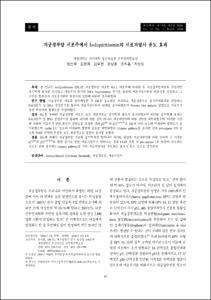KUMEL Repository
1. Journal Papers (연구논문)
1. School of Medicine (의과대학)
Dept. of Obstetrics & Gynecology (산부인과학)
자궁경부암 세포주에서 Isoliquiritizenin의 세포자멸사 유도 효과
- Keimyung Author(s)
- Kwon, Sang Hoon; Cho, Chi Heum; Cha, Soon Do
- Department
- Dept. of Obstetrics & Gynecology (산부인과학)
- Journal Title
- 대한부인종양콜포스코피학회지
- Issued Date
- 2006
- Volume
- 17
- Issue
- 1
- Abstract
- Objective:Isoliquritizenin (ISL) is a chalcone flavonoid, present in licorice, shallot and bean sprouts, has cancer preventing properties and often used in chinese medicine. In this study, ISL to determine its effect on cell proliferation and cell cycle progression in human cervical cancer cells were evaluated.
Methods:Cell viability assay was carried out to determine the viability of human cervical cancer cells. We tested the several experimental methods for verification and functional identification, including MTT assay, FACS analysis, DNA fragmentation assay, and Western blot analysis for ISL treated human cervical cancer cells (HeLa).
Results:ISL, induced growth inhibition in a dose dependent manner, treatment with 50μM/L ISL blocked 50% cell growth. FACS results showed that there was no change in the S phase, but on the other hand ISL increased the percentage of cells in G1 phase. DNA fragmentation assay by ELISA was done to find the rate of apoptosis. Apoptosis took place but in a reduced manner. From Western blot analysis, it revealed ISL induced the expression of p21Cip1/Waf1 and p27kip1 but not mediated by p53. Caspase pathway was revealed and cleavage of PARP took place.
Conclusion:ISL, a chalcone flavonoid, inhibited cell proliferation and induced cell cycle arrest at sub G1 by enhancing the production of p21Cip1/Waf1 and p27kip1. These results indicate that ISL will be a promising agent for use in chemopreventive or therapeutic against human cervical cancer cells.
Key Words : Chalcone flavonoid, Cervical cancer, Apoptosis
목적:본 연구는 isoliquiritizenin (ISL)을 자궁경부암 세포인 HeLa 세포주에 처리한 후 자궁경부암세포의 직접적인 증식억제 효과를 조사하고 세포주기 분석과 DNA fragmentation 분석을 통하여 세포자멸사와의 연관성을 규명하고 그 기전을 밝히고자 세포주기관련 유전자의 발현에 대하여 조사하였다.
연구 방법:자궁경부암 세포를 일차배양한 후 ISL을 농도별로 처리하고 세포생존수로 증식억제효과를 관찰하고 FACS분석 및 DNA 분절분석을 통하여 세포자멸사와의 관계를 조사하였으며 Western blot analysis 방법으로 세포주기 관련 유전자의 발현도를 측정하였다.
결과:ISL을 투여한 자궁경부암 세포는 농도 의존적으로 증식억제 효과가 증가하였으며 이러한 증식억제 효과는 FACS분석 및 DNA 분절분석을 통하여 괴사에 의한 것이 아니라 세포자멸사에 의한 것임을 확인하였으며, 이러한 기전에 대하여 세포주기 관련 유전자 발현도를 측정한 결과 p27kip1과 p21Cip1/Waf1은 ISL의 처리 농도에 비례하여 발현도가 증가하였으며, cyclin E는 농도에 비례하여 발현의 감소를 확인하였다. Caspase pathway를 조사한 결과 pro-caspase 3의 감소와 PARP 단백의 분절은 농도 의존적으로 발현의 증가를 보였다.
결론:ISL에 의해서 자궁경부암 세포의 증식억제가 일어나며 이러한 현상은 세포자멸사에 의한 것이며 그 기전은 p27kip1과 p21Cip1/Waf1의 발현 증가로 인한 세포자멸사가 일어나는 것과 PARP 분절 및 pro-caspase 3의 발현이 감소하는것으로 보아 종국에는 caspase pathway를 거쳐 세포자멸사를 유도하는 효과가 있는 것으로 생각된다.
중심단어:Isoliquiritizenin (Chalcone flavonoid), 자궁경부암, 세포자멸사
- Alternative Title
- Induction of apoptosis in human cervical cancer cells by isoliquritizenin
- Publisher
- School of Medicine
- Citation
- 정선욱 et al. (2006). 자궁경부암 세포주에서 Isoliquiritizenin의 세포자멸사 유도 효과. 대한부인종양콜포스코피학회지, 17(1), 47–53.
- Type
- Article
- ISSN
- 1226-1742
- Appears in Collections:
- 1. School of Medicine (의과대학) > Dept. of Obstetrics & Gynecology (산부인과학)
- 파일 목록
-
-
Download
 oak-bbb-1236.pdf
기타 데이터 / 778.58 kB / Adobe PDF
oak-bbb-1236.pdf
기타 데이터 / 778.58 kB / Adobe PDF
-
Items in Repository are protected by copyright, with all rights reserved, unless otherwise indicated.